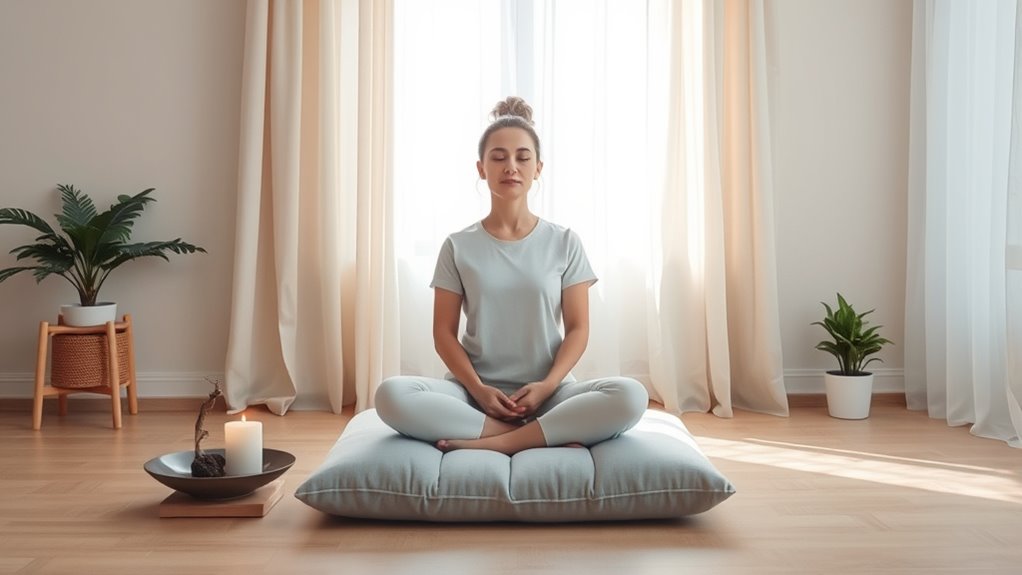To reduce anxiety, try simple meditation techniques like breathing exercises and body scans. Focus on inhaling through your nose for four counts, holding, then exhaling slowly to calm your nervous system. Alternatively, do a body scan by paying attention to sensations from your toes to your head, releasing tension as you go. These approaches help you stay present and relax more easily—discover how these methods can become part of your daily calm routine.
Key Takeaways
- Practice deep breathing exercises, inhaling through the nose for 4 counts, holding, then exhaling slowly to calm the nervous system.
- Use body scan techniques to systematically focus on physical sensations and release tension throughout the body.
- Incorporate mindfulness meditation to observe thoughts non-judgmentally and reduce mental chatter associated with anxiety.
- Engage in regular meditation routines to build emotional resilience and promote long-term stress management.
- Combine breathing and body scan exercises for quick relief during stressful moments, enhancing mental clarity and relaxation.

Are you looking for a natural way to ease your anxiety? If so, incorporating simple meditation techniques into your daily routine can make a notable difference. One effective method is practicing breathing exercises, which help calm your nervous system and bring your focus back to the present moment. To start, find a comfortable seated position and take slow, deep breaths. Inhale through your nose for a count of four, hold for a count of four, and then exhale slowly through your mouth for the same duration. Repeat this cycle several times. This practice reduces your heart rate, lowers blood pressure, and diminishes feelings of stress, making it easier to manage anxious thoughts. Breathing exercises are accessible and can be done anywhere, anytime you need a quick mental reset.
Another powerful technique is the body scan, which encourages you to pay close attention to physical sensations throughout your body. Begin by lying down or sitting comfortably and closing your eyes if you like. Start at your toes and gradually move upward, noticing any tension, discomfort, or areas of relaxation. As you scan each area, breathe into any tension you find, imagining the breath flowing into those spots to release tightness. This practice anchors your awareness in your body, helping you detach from racing thoughts or worries that fuel anxiety. The body scan also promotes relaxation by increasing your awareness of physical sensations, which often get overshadowed by mental chatter during anxious moments.
In addition, understanding the importance of home cinema projectors can be a relaxing activity in itself, providing a cozy environment for meditation or unwinding after a stressful day. Integrating these techniques into your daily routine can markedly reduce anxiety over time. The key is consistency—dedicate a few minutes each day to practice breathing exercises or a body scan. Over time, you’ll develop a greater sense of control over your emotional state and learn to respond to stress more effectively. These methods are gentle, non-invasive, and empower you to manage anxiety without relying on medication or external interventions. When you encounter stressful situations, taking a moment to engage in a breathing exercise or perform a quick body scan can help you regain clarity and calmness. Remember, the goal isn’t to eliminate anxiety completely but to equip yourself with practical tools to handle it when it arises. With patience and practice, these meditation techniques can become valuable allies in your journey toward greater mental peace and emotional resilience.
Frequently Asked Questions
Can Meditation Replace Medication for Anxiety?
Meditation isn’t a complete replacement for medication, especially if you have severe anxiety. It can be a helpful supplement, but many people rely on medication to manage symptoms effectively and avoid dependency. Comparing meditation vs therapy, meditation offers relaxation, but therapy addresses root causes. Talk to your healthcare provider to create a balanced plan that suits your needs and guarantees safe, effective anxiety management without unnecessary dependency.
How Long Should I Meditate Daily for Anxiety Relief?
You should meditate for about 10 to 20 minutes daily for anxiety relief, creating a calming routine that clears your mind, eases your worries, and grounds your spirit. Consistency matters most, so aim for a duration that fits your schedule and feels manageable. As you build this habit, you’ll notice your anxiety diminishes, your focus sharpens, and your overall well-being blossoms like a peaceful garden in full bloom.
Are There Specific Meditation Types Best for Anxiety?
Yes, certain meditation types are especially effective for anxiety. You should focus on mindfulness practice, which helps you stay present and reduce racing thoughts. Incorporate breathing exercises to calm your nervous system and lower stress levels. These techniques can be practiced daily, even for a few minutes, to help manage anxiety better. Consistent use of mindfulness and breathing exercises can markedly improve your emotional well-being.
Can Meditation Cause Increased Anxiety in Some People?
About 20% of people report increased anxiety from meditation, highlighting some mindfulness misconceptions. You might experience meditation risks if you’re sensitive or unprepared, which can lead to heightened feelings of anxiety or discomfort. It’s essential to approach meditation gradually and seek guidance if needed. If you notice increased anxiety, stop and consult a mental health professional. Remember, meditation is not one-size-fits-all, and it’s okay to explore different methods.
Is Prior Meditation Experience Necessary to Benefit From Techniques?
No, prior experience isn’t necessary to benefit from meditation techniques. These practices are designed to be accessible for beginners, so you can start anytime without feeling overwhelmed. Many techniques are simple and easy to follow, making them beginner-friendly. With consistent practice, you’ll notice improvements in your anxiety levels regardless of your prior meditation experience. So, don’t hesitate to begin—everyone starts somewhere, and these methods are meant to be accessible to all.
Conclusion
As you close your eyes and take a deep breath, imagine a calm lake at dawn, its surface smooth and shimmering. With each mindful moment, you’re gently rippling that stillness, releasing worries like leaves floating away. Remember, these meditation techniques are your boat, guiding you across turbulent waters to peaceful shores. Keep practicing, and soon, tranquility will become your safe harbor, always ready to welcome you back whenever anxiety tries to take hold.








